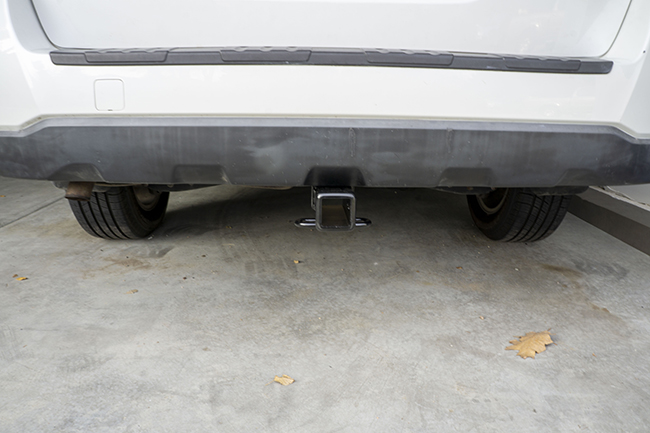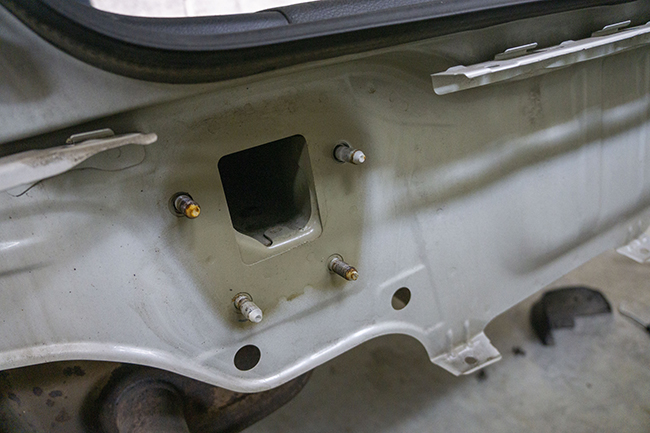Draw-Tite Max Frame — class III, two inch trailer hitch — installation on 2010 Subaru Outback — review
© 2020 Peter Free
10 January 2020

Draw-Tite Max Frame receiver hitch is item 76227 — at etrailer.com
I installed the Max Frame on a 2010 Subaru Outback.
What follows may serve as a cautionary tale for other 2010 (and perhaps 2011) Outback owners.
Max Frame imitates Subaru's placement of its own hitch
Both attach to the rear bumper's eight fastening bolts. You have to remove the car's bumper fascia to get to them.
Etrailer's other hitch choices mount forward of the bumper bolts and under the unit car body. Installing them does not require removing and cutting the car's bumper fascia.
Installation videos — notice that
Etrailer's installation videos show 2017 through 2019 Subaru Outbacks. Not the 2010.
The bumper fascia panel on the 2010 — and presumably the 2011, which reportedly is identical — aligns and attaches to the car slightly differently than the newer cars.
Installation appears to be easier on the newer cars.
For example, Subaru moved one of the 2010 wheel well clips to an easier to see and get at location in later years.
On the 2010, I had to remove both rear wheels to get to some of the fascia attachment pins.
My 2010 Outback presented two more glitches peculiar to it


Those included:
invisibly out of whack bumper fascia alignment — causing stresses probably originating from the manufacturing assembly line
and
the bumper's painted, corroded nuts and bolts.
Taken together, these flaws roughly tripled the installation time stated by most reviewers. And I'm experienced at working on cars.
By way of illustration, my car's bumper nuts required a 20 inch pipe, attached to a three-eighths socket set breaker bar, to get off.
On four of the eight bolts, I had to use the pipe extension throughout the nuts' full travel. Every turn palpably threatened to break something.
I had to use the same pipe to get the nuts back on. Even after cleaning, brushing and lubricating all the threads.
Manufacturer's instructions — regarding placement and dimensions of the fascia cut — are mistaken
These cuts are necessary to allow the Max Frame receiver to protrude through the bumper fascia.
The instruction sheet and diagram that come with the Max Frame are not helpful, regarding exactly how to measure where to put the cut. Obtuse is descriptive.
But — no problem
If you are at all mechanically inclined, you will have no trouble properly placing your slices.
In the 2010's case, the center rear body tab — which the installation videos have you bend up, so as to make room for the hitch — has a pin-attaching hole through its center.
Once you have the hitch installed, you will see that this tab hole exactly aligns with the center vertical axis of the hitch.
This, in turn, means that you can use the hole in the fascia bottom to make your measurements. That's because both holes align to accept the center-placed plastic clip pin that you removed to begin removing the fascia.
Measure from the center of this fascia hole.
Dimensions of the fascia cut
Width of cut
Four inches wide, as the instructions say, is correct.
If you make the cut narrower — so as to match the actual 3.75 inch dimensions of the receiver — you run the risk of having inadvertently slightly out of square cuts cause the fascia to bind on the hitch, when you reinstall the fascia.
I know, 'cause that's what I evidently did.
If this happens, you will not be able to get the fascia to reconnect properly to the attachment line on the car body. The panel will be tilted too much, in one direction or another, to fit back into the body's line of attachment slots.
Vertical cut
For my 2010 Outback, the instructions' 4.5 inch vertical cut was too short.
I had to make mine 5.25 inches (bottom to top) to clear the hitch.
Any shorter than that, and the fascia binds (too far aft) on the receiver portion of the hitch.
If the cutout is not tall enough, two things happen:
First, the fascia will not properly align with the attachment ridge (on the car body) that you took it from. Its top will dip too far forward to slide into the attachment tabs on the car body.
Second, the fascia panel will not slide far enough under the car to allow you to line it back up — with the two remaining pin-retention holes that are located along the car bottom under the bumper.
All things considered, three reasons why . . .
I would not buy the Max Frame (again) for use on a 2010 Outback.
First — fascia and bumper removal turned out to be riskier than advisable
The former, due to probable manufacturing or design flaws.
And the latter, due to (a) the Subaru's curious decision to paint bumper bolts and (b) the car's age and the humid climates that it has lived in.
Second — unnecessary stoutness
The Max Frame's stoutly heavy construction is very visibly out of proportion to the 2010 Outback's spindly bumper nuts and bolts.
This is pertinent because the Max Frame's mounting plate — which sandwiches on the bolt length behind the reinstalled Subaru bumper (and its foam covering) — is thick enough to increase how far the bumper projects backward.
This rearward projection apparently made it more difficult to get my bumper fascia panel reattached to my particular car.
It had been a "bitch" getting the fascia off in the first place, especially along the car's passenger side.
It was a ten-fold demon getting it back on. The dimensions had (apparently) changed enough to aggravate the manufacturing error that made proper alignment so difficult in the first place.
Note
I considered removing the foam on the bumper to make up for the bumper's now increased rear projection.
I decided not to because I did not want the plastic fascia panel possibly banging against the steel bumper on rough roads.
Now, let's evaluate whether the Max Frame's heavy construction is more useful (than not) in the Outback's case.
The hitch weighs 32.5 pounds, dwarfing the mass of the car's bumper and bolts. Add in a two inch ball assembly and locking pin, and you are up to a total of 43 pounds.
The Max Frame has a tongue weight of 600 pounds. The car, 200.
The Max Frame will pull 4,000 pounds. The car, 2,700 — on a largely imaginary day:
If you read the 2010's owner's manual, you will see that Subaru's hill and ambient temperature disclaimers turn the vehicle into a 1,500 to 1,700 pounds maximum towing vehicle.
Experienced towers on Subaru forums effectively agree with this. Unless, they live on flat ground in cool climates.
From my post-installation perspective, the stout Max Frame is arguably overkill for the Outback.
Third — copying Subaru's own hitch location appears to be of little non-aesthetic benefit
A number of Etrailer reviewers expressed concern that using a hitch that does not mount to the bumper bolts might interfere with Subaru's crumple zone engineering.
However, in repeatedly crawling around under the car, I saw no obvious engineering advantage to using the Max Frame, as compared to Etrailer's underbody hitch choices.
It seems to me that both kinds of hitches are going to be subject to the random-like specifics of each collision.
This (debatable) randomness makes discussions, as to which hitch kinds and mounting locations are better, moot.
Moot that is, unless someone with time and money to burn (crashing car after car in accident simulations) can demonstrate that:
a certain kind of collision
with the shape and mass specifics of "other" vehicles
is going to occur proportionately more often
and in uniquely specific orientations —
than with
other vehicles
and
other orientations.
You get what I'm driving at. Because the Outback was never really designed to tow seriously or often, I doubt that anyone spent significant time figuring the pluses and minus of various hitch locations into the body's design.
Subaru almost certainly put their factory hitch where it was (and is) because it looks good and also makes it more difficult for customers to do themselves. Having owned Subarus for more than 17 years, I can attest to the fact that Subaru capitalism is all about "encouraging" owners into their service departments.
In sum, I tend toward dismissing the crumple zone argument as persuasive with regard to choosing the Max Frame.
This dismissal leaves only the Max Frame's virtue of hiding its horizontal cross piece behind the car's bumper fascia. That's important to many people. But aesthetic considerations are not enough, to my mind, to outweigh the time-consuming aggravations that I encountered installing it on my sample of the 2010 Outback.
Consider, in that regard, an event in which one or more of the car's bumper bolts broke off, stripped, or had a nut seize.
The result? Tedious extraction, cutting or drilling —probably followed by welding.
Also take into account what would have happened afterward, if the already stressed fascia on my particular car could not have been fitted back into a semblance of proper place. An expensive trip to the body shop.
None of this is prohibitive. Persistence and money overcome all sorts of problems.
But still . . .
The moral? — Great hitch — but . . .
In retrospect, avoiding what I encountered in installing the Max Frame, on a car that cannot use its overkill strength, seems desirable.
If I were going to do this again, I would use one of Etrailer's underbody hitch choices on my 2010.
This qualification does not to detract from the Max Frame's excellence. It is a darn nice hitch.
And if Etrailers' consistently favorable reviews are an indicator, the Max Frame works superbly on Outbacks newer than mine.
 PeteFree.com
PeteFree.com